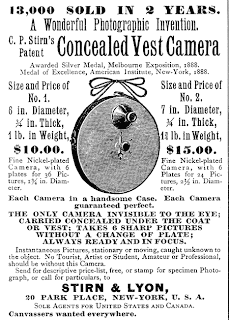By Douglas Kendall, Curator of Collections
These days, cameras are everywhere. Wherever there’s a smart phone, there’s a camera. Sales of dedicated cameras are down; the almost-universal acceptance of the camera in a phone has even affected recently chic devices such as the Flip Video camera, which is going out of production.
The only thing really new about this phenomenon of cameras that don’t look like cameras is its ubiquity. There must have been a demand for concealed cameras early in the development of photography. By the 1880s, inventors had created cameras designed to look like hats, satchels, books, binoculars, walking sticks and (my personal favorite) revolvers. Pulling a camera that looks like a gun seems like a sure way to reduce the population of photographers quickly.
Cooperstown’s own Arthur Telfer, whose photographs can be seen via the Fenimore Art Museum’s Collections page, owned a camera designed to be hidden behind the photographer’s vest. The disc-shaped design was patented by Robert D. Gray of New York City in 1886; he soon sold the patent to one C. P. Stirn. The camera was manufactured for and marketed by Stirn & Lyon of New York and was also sold in Germany. The relatively thin disc was held behind a man’s vest; the lens aligned with a buttonhole.
Vest Camera
Nickel-plated brass
Made for Stirn & Lyon, New York, NY, ca. 1888
Gift of Arthur J. Telfer, N0064.1945. Photo: Douglas Kendall
How did the Vest Camera work in practice? The directions made it sound simple: “place it under the coat or vest in such a manner as to show only the lens, which, in the shape of a button, is fastened in a button-hole, thus giving the Camera a firm, steady position. In order to secure a good, clear picture, place your right hand over the vest exactly where the Camera is hidden, point the lens toward the centre of the object to be photographed and, by pulling with your left hand on the string hanging from the lower part of the Camera, you secure the first picture. Now turn the centre screw or button of the Camera with the dart to No. 2, which causes the Dry Plate to change its position and makes it ready for the next picture; continue thus until six pictures are taken and after that change the Plate for a new one in the dark-room and again you are ready for six more pictures."
I have to wonder how long the secretive camera bug would be able to maintain the deception while engaged in all those awkward hand movements. But apparently the idea of the Vest Camera captivated a lot of Americans. The company’s ads claimed that 13,000 had been sold within two years of Gray’s patent. In 19th century terms, it was probably nearly as big a sensation as the Flip was in the 21st century. It’s not clear how long the craze lasted, but specialized accessories were still being introduced in 1889.
“C. P. Stirn’s Patent Concealed Vest Camera”
Advertisement for the C.P. Sterns, Concealed Vest Camera, published in the April issue of Scribners magazine, 1889. Found at: Historic Camera
We don’t know why Arthur Telfer acquired a Concealed Vest Camera, but he kept it until 1945, when he gave it to the New York State Historical Association, parent of the Fenimore Art Museum. A few years later, Telfer gave NYSHA the entire collection of glass-plate negatives taken by him and his predecessor and partner, Washington Smith, beginning in 1853.

































